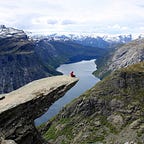A Trek Through a Slice of History
Lighthouse Park, West Vancouver
An early morning start on a Friday brought us to Lighthouse Park in West Vancouver before 8 am. There were few cars at the parking lot under tall trees. Lighthouse Park is one of the last refuges of old-growth trees in Vancouver. One must visit either Vancouver Island or Haida Gwaii to see others.
We walked down the Shore Pine trail along tall red cedar and Douglas Fir trees, some of them 500 years old. Barely 10 minutes in, we stopped to read about the local fauna when something came crashing down from the tree beside me. I moved away and looked up as more of them came shooting down. Just as I was reading about a chipmunk species that lives in the forest, the same little creature sent down projectiles of tender fir cones from the canopy, that it would later come down to collect and store in its winter cache.
The mossy rainforest led to a rocky outcrop with a view of Vancouver’s skyline across the point where the Pacific Ocean flowing inland becomes the Burrard Inlet. A couple of girls were lying down gossiping about a boy as I took pictures of the silhouettes of Downtown Vancouver and the Lion’s Gate Bridge in the bright morning light.
The trail led down a flight of steps to a rocky beach which revealed the building that gives its name to the park. Named Point Atkinson by navigator-explorer George Vancouver, the spot has the first non-Native construction in the Vancouver region built in 1875. The concrete white lighthouse with its bright red top replaced this old wooden structure in 1912. As I looked at this construction, there were illegal fishing boats trying to get a catch near the shore.
Up on the rocks were arbutus trees with green trunks that photosynthesise. As they grow taller, their brown bark keeps peeling off. This is a micro-climate that supports them as they need rocky surfaces facing the sun but they don’t grow in Vancouver city which is just next door.
The trail led up to the lighthouse itself and the former residence of the keepers who led their solitary lives there. It is probably rented out as a hotel today.
The trail led to another viewpoint with a sign saying that whales could be seen from there. There were images of orcas, humpback whales and harbour seals. Those images were all I saw of those creatures during this hike.
I enjoyed the walk through the big moss-covered trees listening to woodpeckers drill tree trunks and chipmunks drop down their food before scampering down to hide them. As is common in most parks around Vancouver, signs warned of the presence of bears and what to do if one were to encounter them here.
There were logs of massive trees lying across the trail at several spots. One such log was considered to be a nurse log as it nurtured a number of organisms during its slow process of disintegration into humus.
It was nearly 10 am when we exited the park to find a parking lot brimming with cars and people. We were lucky to have had it mostly to ourselves. It was a pleasant visit that combined a historic site as well as ancient trees that human activity has rendered rare in this region. Even though 140 years is hardly historic in the place I come from, it was interesting to explore this spot and learn more about my place of adoption.
Hi, I am Prajwal Madhav. I hope you enjoy my posts.
